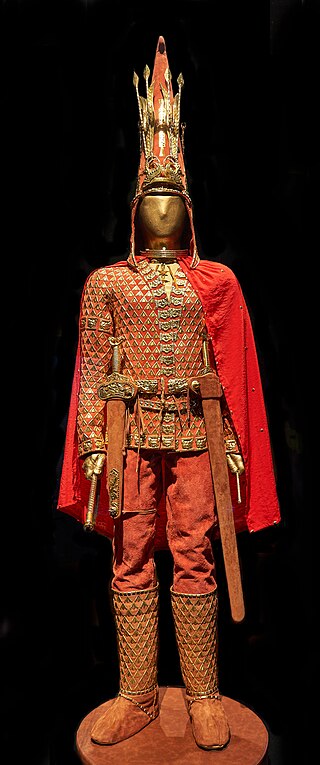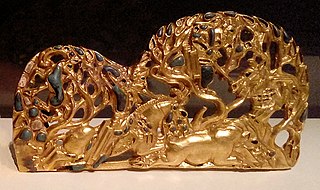The Androphagi were an ancient Scythian tribe whose existence was recorded by ancient Greco-Roman authors.

The Scythians or Scyths in composition) and sometimes also referred to as the Pontic Scythians, were an ancient Eastern Iranic equestrian nomadic people who had migrated during the 9th to 8th centuries BC from Central Asia to the Pontic Steppe in modern-day Ukraine and Southern Russia, where they remained established from the 7th century BC until the 3rd century BC.

The Cimmerians were an ancient Eastern Iranic equestrian nomadic people originating in the Pontic–Caspian steppe, part of whom subsequently migrated into West Asia. Although the Cimmerians were culturally Scythian, they formed an ethnic unit separate from the Scythians proper, to whom the Cimmerians were related and who displaced and replaced the Cimmerians.

The Saka were a group of nomadic Eastern Iranian peoples who historically inhabited the northern and eastern Eurasian Steppe and the Tarim Basin.

The Agathyrsi were an ancient people belonging to the Scythian cultures who lived in the Transylvanian Plateau next to the Sigynnai and Sindos, in the region that later became Dacia. The Agathyrsi are largely known from Herodotus of Halicarnassus's description of them in the 5th century BC.

The Massagetae or Massageteans, also known as Sakā tigraxaudā or Orthocorybantians, were an ancient Eastern Iranian Saka people who inhabited the steppes of Central Asia and were part of the wider Scythian cultures. The Massagetae rose to power in the 8th to 7th centuries BCE, when they started a series of events with wide-reaching consequences by expelling the Scythians out of Central Asia and into the Caucasian and Pontic Steppes. The Massagetae are most famous for their queen Tomyris's alleged defeating and killing of Cyrus, the founder of the Persian Achaemenid Empire.

Scytho-Siberian art is the art associated with the cultures of the Scytho-Siberian world, primarily consisting of decorative objects such as jewellery, produced by the nomadic tribes of the Eurasian Steppe, with the western edges of the region vaguely defined by ancient Greeks. The identities of the nomadic peoples of the steppes is often uncertain, and the term "Scythian" should often be taken loosely; the art of nomads much further east than the core Scythian territory exhibits close similarities as well as differences, and terms such as the "Scytho-Siberian world" are often used. Other Eurasian nomad peoples recognised by ancient writers, notably Herodotus, include the Massagetae, Sarmatians, and Saka, the last a name from Persian sources, while ancient Chinese sources speak of the Xiongnu or Hsiung-nu. Modern archaeologists recognise, among others, the Pazyryk, Tagar, and Aldy-Bel cultures, with the furthest east of all, the later Ordos culture a little west of Beijing. The art of these peoples is collectively known as steppes art.
The Melanchlaeni, also known as the Saudaratae, were an ancient Scythian tribe whose existence was recorded by ancient Graeco-Roman authors.

The Sigynnae were an obscure nomadic people of antiquity belonging to the Scythian cultures who lived in the region corresponding to parts of present-day Hungary.
Madyes was a Scythian king who ruled during the period of the Scythian presence in West Asia in the 7th century BCE.
The Budini were an ancient Scythian tribe whose existence was recorded by ancient Graeco-Roman authors.
Scythia or Scythica, also known as Pontic Scythia, was a kingdom created by the Scythians during the 6th to 3rd centuries BC in the Pontic–Caspian steppe.
Sandakshatru or Sandakuru was the last known Cimmerian king.
Bartatua or Protothyes was a Scythian king who ruled during the period of the Scythian presence in Western Asia in the 7th century BCE.
Išpakāya was a Scythian king who ruled during the period of the Scythian presence in Western Asia in the 7th century BCE.

The Scythian culture was an Iron Age archaeological culture which flourished on the Pontic-Caspian steppe in Eastern Europe from about 700 BC to 200 AD. It is associated with the Scythians, Cimmerians, and other peoples inhabiting the region of Scythia, and was part of the wider Scytho-Siberian world.

The Scytho-Siberian world was an archaeological horizon that flourished across the entire Eurasian Steppe during the Iron Age, from approximately the 9th century BC to the 2nd century AD. It included the Scythian, Sauromatian and Sarmatian cultures of Eastern Europe, the Saka-Massagetae and Tasmola cultures of Central Asia, and the Aldy-Bel, Pazyryk and Tagar cultures of south Siberia.
The Sauromatian culture was an Iron Age culture of horse nomads in the area of the lower Volga River to the southern Ural Mountain, in southern Russia, dated to the 6th to 4th centuries BCE. Archaeologically, the Sauromatian period itself is sometimes also called the "Blumenfeld period", and is followed by a transitional Late Sauromatian-Early Sarmatian period, also called the "Prokhorov period".

The Scythian kingdom in Crimea was a kingdom created by the Scythians during the 3rd century BCE in Crimea.
The names of the Scythians are a topic of interest for classicists and linguists. The Scythians were an Iranic people best known for dominating much of the Pontic steppe from about 700 BC to 400 BC. The name of the Scythians is believed to be of Indo-European origin and to have meant "archer". The Scythians gave their name to the region of Scythia. The Persians referred to all Iranic nomads of the steppes, including the Scythians, as Sakas. Some modern scholars apply the name Scythians to all peoples of the Scytho-Siberian world, but this terminology is controversial.










